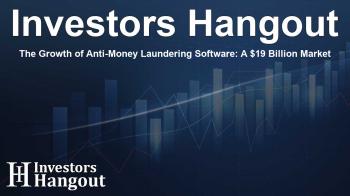The Growth of Anti-Money Laundering Software: A $19 Billion Market

The Growth Prospects of Anti-Money Laundering Software
The anti-money laundering (AML) software market is experiencing remarkable growth and is projected to reach $19 billion by 2033, according to a recent analysis. This is a substantial increase from $4 billion in 2023, translating to a robust compound annual growth rate (CAGR) of 16.7% during the forecast period from 2024 to 2033.
Understanding Market Drivers
Several factors contribute to the significant expansion of the AML software sector. One of the primary drivers is the increasing prevalence of online payment modes in bank transactions. As more individuals and businesses engage in digital financial interactions, the necessity for effective AML solutions has surged dramatically. Strict regulations governing financial transactions are also pushing institutions to prioritize compliance, which further fuels the demand for AML software.
Regulatory Compliance and Security Needs
The rise in strict regulations pertaining to anti-money laundering has made it imperative for financial institutions to adopt sophisticated software solutions. These regulations aim to combat financial crimes effectively and require banks and other financial entities to have robust systems in place to facilitate compliance. Failure to comply can result in severe penalties, which underscores the importance of implementing effective AML strategies.
Technological Advancements and Consumer Adoption
Additionally, the rapid adoption of internet solutions and advanced technologies has bolstered the AML software market. With businesses scrambling to integrate these technologies, the use of AML software is becoming essential for identifying and mitigating risks associated with money laundering. Furthermore, analytics solutions are gaining traction as companies strive to enhance their operational efficiency and risk management capabilities.
Segment Analysis of the Market
Breaking down the components of the AML software market, it's evident that the software segment accounted for the largest share in 2023. Financial institutions are increasingly leaning towards comprehensive AML solutions, leveraging technology to maintain compliance with regulatory demands and effectively monitor suspicious activities.
Focus on Transaction Monitoring
By product type, transaction monitoring has emerged as a dominant segment, making up more than 40% of market revenue. This segment is crucial as it allows for the continuous evaluation of financial transactions, identifying any anomalies that could indicate potential money laundering activities. The effectiveness of transaction monitoring solutions is vital for ensuring compliance and safeguarding against financial crimes.
The Role of Deployment and Organization Size
In terms of deployment, on-premise solutions have seen the most acceptance as they provide organizations with increased control over sensitive financial data. This is particularly important in industries such as finance and banking, where data privacy is paramount. Large enterprises, which contribute significantly to market revenue, are driving the demand for advanced AML solutions that accommodate their complex operational frameworks.
Regional Insights and Future Outlook
Geographically, North America maintained its dominant position in the AML software market in 2023, backed by substantial investments in technology and competitive gaming infrastructures. The increasing base of digital transactions and the growing need to safeguard financial interactions continue to drive demand within this region.
As we look ahead, the outlook for the AML software market remains positive. Industry players, including major firms like LexisNexis Risk Solutions and Moody's Corporation, are continuously innovating to enhance their product offerings. Their strategies, which involve launching new products and forming collaborations, will be key to their success in this rapidly evolving market.
Frequently Asked Questions
What is the projected size of the anti-money laundering software market by 2033?
The market is projected to reach $19 billion by 2033, growing from $4 billion in 2023.
What factors are driving the demand for AML software?
Key drivers include the rise of online payments, strict regulatory compliance requirements, and the increased adoption of advanced technologies.
Who are the major players in the AML software market?
Significant market players include LexisNexis Risk Solutions, Thomson Reuters Corporation, and SAS Institute Inc.
What segment accounted for the largest market share in 2023?
The transaction monitoring segment held the largest share, crucial for identifying suspicious financial activities.
Which region led the AML software market in 2023?
North America led the market, driven by its established financial frameworks and technological advancements.
About The Author
Contact Olivia Taylor privately here. Or send an email with ATTN: Olivia Taylor as the subject to contact@investorshangout.com.
About Investors Hangout
Investors Hangout is a leading online stock forum for financial discussion and learning, offering a wide range of free tools and resources. It draws in traders of all levels, who exchange market knowledge, investigate trading tactics, and keep an eye on industry developments in real time. Featuring financial articles, stock message boards, quotes, charts, company profiles, and live news updates. Through cooperative learning and a wealth of informational resources, it helps users from novices creating their first portfolios to experts honing their techniques. Join Investors Hangout today: https://investorshangout.com/
The content of this article is based on factual, publicly available information and does not represent legal, financial, or investment advice. Investors Hangout does not offer financial advice, and the author is not a licensed financial advisor. Consult a qualified advisor before making any financial or investment decisions based on this article. This article should not be considered advice to purchase, sell, or hold any securities or other investments. If any of the material provided here is inaccurate, please contact us for corrections.

